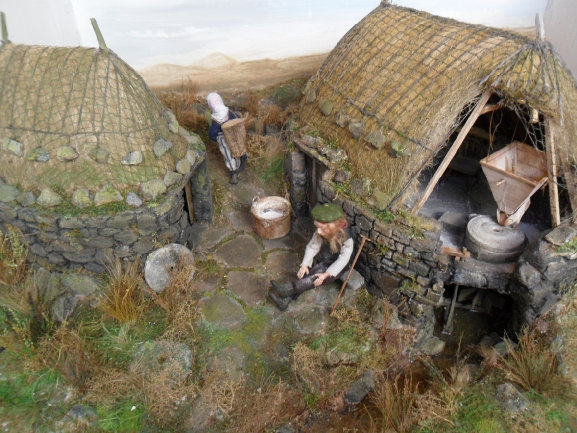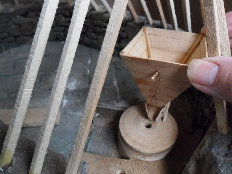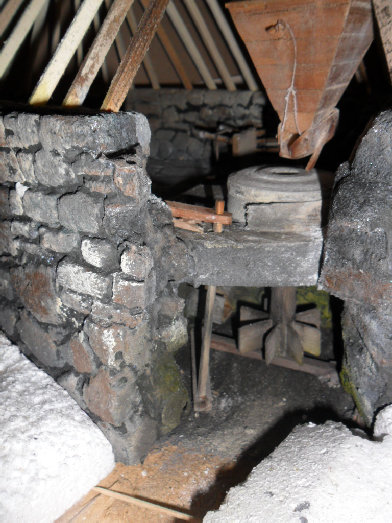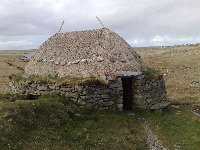

NORSE MILL
Norse mill or Click Mill So called because of the clicking noise made by the 'clapper' dragging on the revolving millstone as it shook the 'shoe' below the hopper & sprinkled grain into the eye of the stone..
This model will show how the click mill worked, the paddles were set horizontally below the floor of the crudely made double dry stone walled building. It was built & used by crofters in the Isle of Lewis & other Scottish islands following a design which originated in Scandinavia hundreds of years ago.
Timber was scarce in such a barren landscape and the roof structure was built of timbers often salvaged from the beach & covered in crude thatching, various materials were used for the thatch including Barley straw, which was considered the best, alternatives could be moor grass,reeds or Heather depending on what was easily available.
This was laid on top of sods of turf or in some cases large thin sheared stones, these would be crudely fixed using wooden pegs on top of the roof poles simply as a method of support for the thatching..
The straw was laid thickly on top of this, often in a very haphazard way and frequently screwed up in all directions and not at all like traditional thatching using straight bundles of straw with pegs & dowels to keep the thatch in place.
Instead, In order to keep the thatch in place it was covered in old fishing nets and roped and weighted down with stones on top of the walling and also further up the roof in a neat rope twisted design with the end result looking most pleasing.
A pole projects out of each end of the rounded roof (called crow poles) to give anchorage to the roping of the roof to enable the structure to survive in such an exposed windswept area.
This model will show how the click mill worked, the paddles were set horizontally below the floor of the crudely made double dry stone walled building. It was built & used by crofters in the Isle of Lewis & other Scottish islands following a design which originated in Scandinavia hundreds of years ago.
Timber was scarce in such a barren landscape and the roof structure was built of timbers often salvaged from the beach & covered in crude thatching, various materials were used for the thatch including Barley straw, which was considered the best, alternatives could be moor grass,reeds or Heather depending on what was easily available.
This was laid on top of sods of turf or in some cases large thin sheared stones, these would be crudely fixed using wooden pegs on top of the roof poles simply as a method of support for the thatching..
The straw was laid thickly on top of this, often in a very haphazard way and frequently screwed up in all directions and not at all like traditional thatching using straight bundles of straw with pegs & dowels to keep the thatch in place.
Instead, In order to keep the thatch in place it was covered in old fishing nets and roped and weighted down with stones on top of the walling and also further up the roof in a neat rope twisted design with the end result looking most pleasing.
A pole projects out of each end of the rounded roof (called crow poles) to give anchorage to the roping of the roof to enable the structure to survive in such an exposed windswept area.



Here are some photo's of the model during construction, the left photo shows the interior more or less finished, a part of the roof & wall will be left missing in order to see inside.
Below the millstones can be seen the undercroft with horizontal wheel and the lightening rod, this is what lifts the top millstone to set the gap and is adjusted by packing wedges under the lever as shown in the photo above. The stone lined chute that runs from the leat alongside the path can be seen at the back of the picture to the right.
On the right is the model with the thatch & roping added, A second model added to the diorama is a smaller building called 'the kiln', this was used to dry the grain to make it suitable for milling, improperly dried grain would be at risk of mould & also clog up the millstones.
The model is finished on the photo to the right,it now has it's human figures to complete the setting.
A woman carries away the basket of newly ground flour on her back using the same basket she brought the grain in earlier in the day whilst the old miller takes a rest
A pair of old discarded millstones add a touch of authenticity to the scene.

Above is a restored mill on the Isle of Lewis and the exterior of the model is based on this. However, contemporary photographs, mostly from the early 20th century, show the thatching & roping to be a lot more untidy than this with the covering of thatch applied in a very haphazard way but it may be the result of fighting a losing battle to keep the mill in good order in a very bleak landscape. The 1930's seems to be when they finally fell into dereliction
CLICK MILL
OR
1/12th Scale
